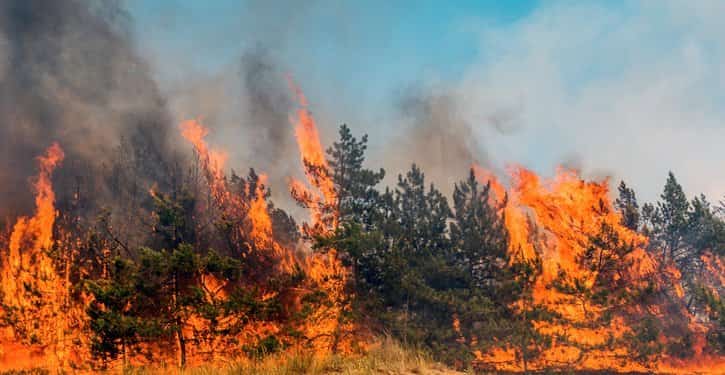How to Prepare for a Wildfire
Many homeowners face the risk of wildfires, which are usually triggered by lightning or accidents. They spread quickly, igniting brush, trees and homes. Reduce your risk of damage by preparing now to protect your family, home and property.
Preparing Your Home for a Wildfire
The following are things you can do to protect yourself, your family and your property in the event of a fire.
- Design and landscape your home with wildfire safety in mind. Select materials and plants that can help contain fire rather than fuel it.
- Use fire-resistant or non-combustible materials on the roof and exterior structure of your house, or treat wood or combustible material used in roofs, siding, decking or trim with fire-retardant chemicals.
- Plant fire-resistant shrubs and trees. For example, hardwood trees are less flammable than pine, evergreen, eucalyptus or fir trees.
- Regularly clean your roof and gutters; remove any debris that could catch fire.
- Inspect your chimneys at least twice a year, and clean them at least once a year. Keep the dampers in good working order. Equip chimneys and stovepipes with a spark arrester.
- Install mesh screen beneath porches, decks, floor areas and the home itself to prevent debris and combustible materials from accumulating. You should also cover openings to floors, roofs and attics with mesh screens to prevent sparks and embers from entering your home.
- Install a dual-sensor smoke alarm on each level of your home, especially near bedrooms; test it every month and change the batteries at least once each year.
- Teach your family members how to use a fire extinguisher (ABC type), and show them where it’s kept.
- Keep household items available that can be used as fire tools, such as a rake, axe, handsaw or chain saw, bucket and shovel.
- Keep a ladder that will reach the roof in case a family member ends up on the roof of a burning house.
- Move flammable items away from the house and outside of your defensible space, including woodpiles, lawn furniture, barbecue grills, tarp coverings, etc.
Plan Your Water Needs
- Have a garden hose that is long enough to reach any area of the home and other structures on the property.
- Install freeze-proof exterior water outlets on at least two sides of the home and near other structures on the property.
- Identify and maintain an adequate outside water source, such as a small pond, cistern, well, swimming pool or hydrant.
- Consider obtaining a portable gasoline-powered pump in case electrical power is cut off.
It is recommended that you create a 10- to 30-metre safety zone around your home. Within this area, you can take steps to reduce potential exposure to flames and radiant heat. Homes built near wooded areas should have a minimum safety zone of 30 metres. If your home sits on a steep slope, standard protective measures may not be enough. Contact your local fire department or forestry office for additional information.
- Rake leaves, dead limbs and twigs. Clear all flammable vegetation. Remove leaves and rubbish from under structures.
- Thin a 5-metre space between tree crowns, and remove limbs within 5 metres of the ground.
- Remove dead branches that extend over the roof.
- Prune tree branches and shrubs within 5 metres of a stovepipe or chimney outlet.
- Ask the power company to clear branches from power lines.
- Mow grass regularly.
- Clear a 3-metre area around propane tanks and the barbecue. Place a screen over the grill, made of a non-flammable material with mesh.
- Regularly dispose of newspapers and rubbish at an approved site. Follow local burning regulations.
- Place stove, fireplace and grill ashes in a metal bucket and soak them in water for two days, then bury the cold ashes in mineral soil.
- Store gasoline, oily rags and other flammable materials in approved safety cans. Place the cans in a safe location away from the base of buildings.
- Stack firewood at least 30 metres away and uphill from your home. Clear combustible material within 6 metres of a woodpile.
- Review your homeowner’s insurance policy and prepare or update a list of your home’s contents.
Follow Local Burning Laws
- Before burning debris in a wooded area, make sure you notify local authorities and obtain a burning permit.
- Use an approved incinerator with a safety lid.
- Create at least a 3-metre clearing around the incinerator before burning debris.
- Have a fire extinguisher or garden hose on hand when burning debris.
During a Wildfire
If you are advised to evacuate, do so immediately. Take your disaster supply kit, lock your home and choose a route away from the wildfire. Watch for changes in the speed and direction of the fire and smoke. Tell someone when you left and where you are going.
If you see a wildfire and haven’t received evacuation orders yet, call 911. Don’t assume that someone else has already called. Describe the location of the fire, speak slowly and clearly and answer any questions the dispatcher asks.
If you are not ordered to evacuate and have time to prepare your home, take the following actions:
- Arrange temporary housing at a friend or relative’s home outside the threatened area in case you need to evacuate.
- Wear protective clothing when outside, such as sturdy shoes, cotton or wool clothes, long pants, a long-sleeved shirt, gloves and a handkerchief to protect your face.
- Gather fire tools such as a rake, axe, handsaw or chainsaw, bucket, and shovel.
- Close outside attic, eaves and basement vents, windows, doors, and other openings. Remove flammable drapes and curtains. Close all shutters, blinds or heavy non-combustible window coverings to reduce radiant heat.
- Close all doors inside the house to prevent drafts. Open the damper on your fireplace, but close the fireplace screen.
- Shut off any natural gas, propane, or fuel oil supplies at the source.
- Connect garden hoses to outdoor water taps and fill any pools, hot tubs, garbage cans, tubs or other large containers with water.
- Place lawn sprinklers on the roof and near aboveground fuel tanks. Leave sprinklers on and dowse these structures as long as possible.
- If you have gas-powered pumps for water, make sure they are fuelled and ready.
- Place a ladder in clear view against the house.
- Disconnect any automatic garage door openers so that doors can still be opened by hand if the power goes out. Close all garage doors.
- Place valuable papers, mementos, and anything “you can’t live without” inside the car in the garage, ready for quick departure. Any pets still with you should also be put in the car.
- Place valuables that will not be damaged by water in a pool or pond.
- Move flammable furniture into the centre of the home away from the windows and sliding glass doors.
- Turn on outside lights and leave a light on in every room to make the house more visible in heavy smoke.
After a Wildfire
The following are guidelines for what to do in the period following a wildfire.
- If you are with burn victims or are a burn victim yourself, call 911 or seek help immediately. Cool and cover burns to reduce the chance of further injury or infection.
- If you remained at home, check the roof immediately after the fire danger has passed. Put out any roof fires, sparks, or embers. Check the attic for hidden burning sparks.
- For several hours after the wildfire, maintain a “fire watch.” Re-check for smoke and sparks throughout the house.
- If you have evacuated, do not enter your home until fire officials say it is safe.
- If you must leave your home because a building inspector says the building is unsafe, ask someone you trust to watch the property during your absence.
- Use caution when entering burned areas as hazards may still exist, including hot spots, which can flare up without warning.
- If you detect heat or smoke when entering a damaged building, evacuate immediately.
- If you have a safe or strongbox, do not try to open it. It can hold intense heat for several hours. If the door is opened before the box has cooled, the contents could burst into flames.
- Avoid damaged or fallen power lines, poles, and downed wires.
- Watch for ash pits and mark them for safety. Warn family and neighbours to keep clear of the pits.
- Watch your pets closely and keep them under your direct control. Hidden embers and hot spots could burn them.
- Follow public health guidance on safe cleanup of fire ash and safe use of masks.
- Dampen debris to minimize inhaling dust particles.
- Wear leather gloves and heavy-soled shoes to protect your hands and feet.
- Properly dispose of cleaning products, paint, batteries, and damaged fuel containers to avoid risk.
- Discard any food that has been exposed to heat, smoke, or soot.
- Do NOT use water that you think may be contaminated to wash dishes, brush your teeth, prepare food, wash your hands, make ice or make baby formula.
- You may find yourself in the position of taking charge of other people. Listen carefully to what people are telling you, and deal patiently with urgent situations first.
In addition to insuring your home, we are committed to helping you and your loved ones stay safe when disaster strikes. If you would like more information on developing a family emergency plan or building a disaster supply kit, please contact Munn Insurance today.
Related News
Recent News
Decoding Commercial Insurance: 20 Essential Terms for Small to Medium-Sized Business Owners
Navigating the world of commercial insurance can be overwhelming, but understanding key terms is crucial for safeguarding your small to medium-sized business. Here are 20 essential terms explained in plain language: General Liability: Coverage protecting [...]
Top 10 Questions to Ask Your Broker Before Buying Insurance for Your Small Business
When purchasing insurance for your small business, it's crucial to ask your insurance broker the right questions to ensure you make informed decisions. Here are the top 10 questions to ask: 1. What Types of [...]
Knowing When to Switch: Finding the Right Insurance Broker for Your Property Portfolio
As a large business engaged in the construction, ownership, and management of numerous commercial properties and apartment buildings, ensuring robust insurance coverage is paramount. However, there may come a time when it's prudent to reassess [...]











